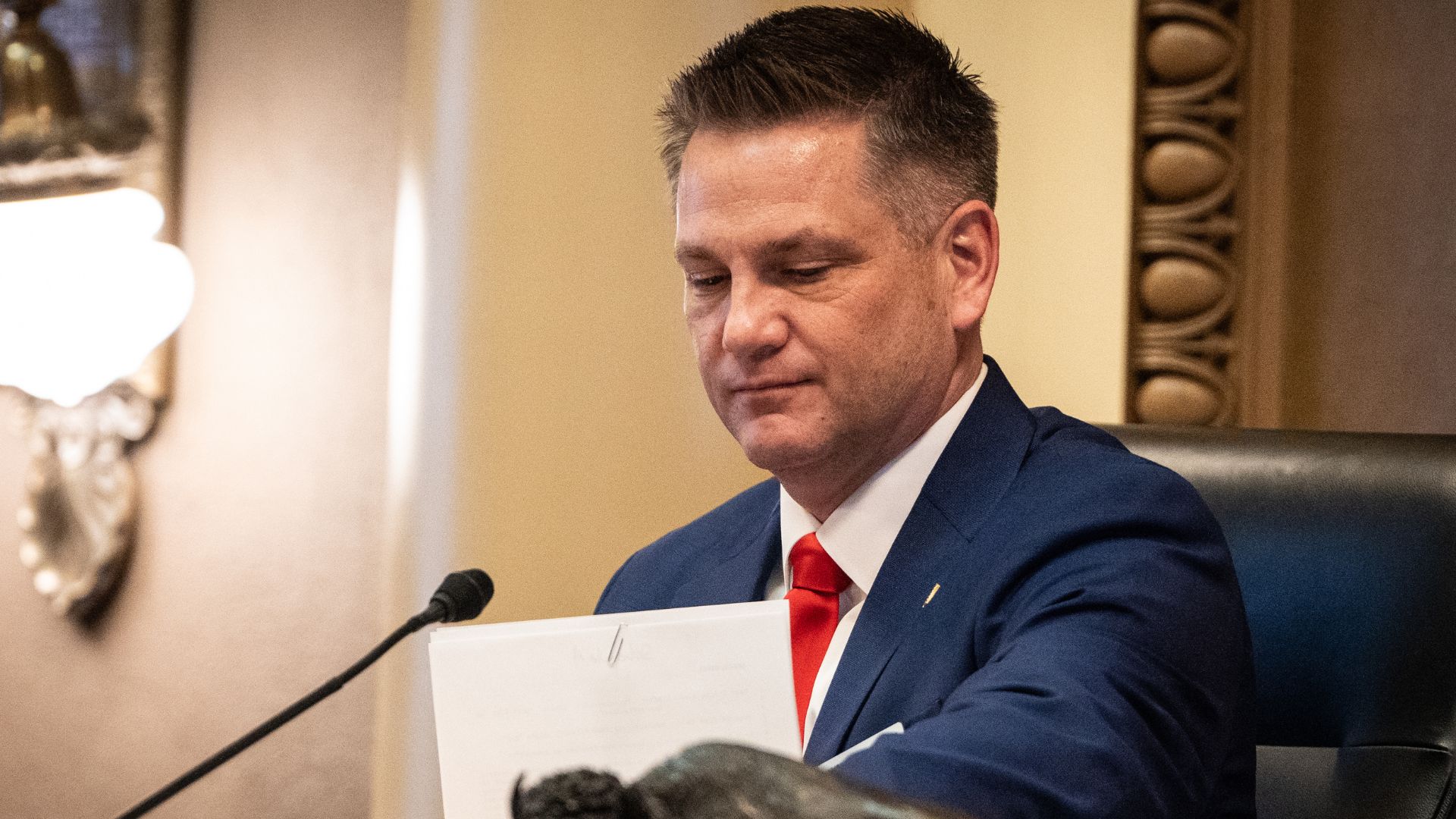Educators fill the room as lawmakers discuss K-12 funding

Sen. Bo Biteman, R-Ranchester, — Photo by Michael Smith
CHEYENNE — It was standing room-only Tuesday morning, the first day of the Wyoming Legislature’s Select Committee on School Finance Recalibration two-day meeting in Casper. Educators, parents and school administrators filled the seats, ready to advocate for public education.
“Wyoming public schools are the heart of many of our communities,” said Better Wyoming Executive Director Nate Martin. “There’s … a growing perception that some of the people who are tasked with upholding and supporting a complete and uniform system of public instruction, per the Constitution, are instead working to undermine it.”
For the first time since a state district court judge found Wyoming has unconstitutionally underfunded its public schools, state lawmakers met to discuss the recalibration of the Legislature’s funding model for K-12 public education.
The Wyoming Supreme Court required the Legislature to recalibrate its funding model for the K-12 school block grant once every five years. While state lawmakers have successfully completed the required recalibration process, a recalibrated funding model has not been adopted since 2010, meaning funding has remained at the same level since then.
In late February, Laramie County District Judge Peter Froelicher ruled Wyoming’s funding model is “unconstitutional” and “no longer cost-based.” He ordered the state to include funding for elementary mental health counselors, school resource officers, nutrition programs and computers for every student.
“The Court notes, because 2025 is a recalibration year, there is an excellent window of opportunity to address these issues,” Froelicher wrote.
State finance consultant Lawrence Picus, with Picus Odden & Associates, included each of these elements in a newly recalibrated model in his presentation before the committee.
Peer review
The judge also gave “diminished credibility” to some of the consulting experts hired by the state for public school funding. Picus told lawmakers a new peer review element will be added to the recalibration process this year.
Wyoming’s top school finance consultants, Christiana Stoddard and Lori Taylor Loden, were specifically named in the court case. Both Stoddard and Loden have worked on the funding model since 2010.
“The judge in the trial had some questions about processes and some issues,” Picus said. “We thought it would be helpful to bring in some additional people to look at their methods and see if there are ways to improve it.”
A school finance expert from the University of Washington will study administrative salaries, he said.
Another labor economist from the University of Arkansas will work with Stoddard to study teacher salaries.
Background
Funding for teachers and administrative staff is a major part of the state’s evidence- based funding model, Picus said.
The model is split into five main categories: staffing for core programs, dollar- per-pupil resources, struggling-student resources, central offices and factors that are specific to Wyoming.
Picus noted that staffing for core programs is “the bulk of the model.” Based on feedback from educational stakeholders and data observed in his research, Wyoming school districts typically spend 80% of their budget on people.
“That’s not only teachers, but all the people who work in a school district,” he said.
Resources are allocated to schools based on student enrollment, with a certain amount of money per student.
“In some elements of the model, that number is inversely related to the enrollment of a school,” he said. “Small schools generate more money per pupil than large schools, so they have enough resources to actually do what’s expected.”
However, there’s concern over how the model treats small, rural schools once they reach a certain student threshold, Picus said.
“There can be as much as $100,000 or $150,000 swing with the change in one student. And that’s very challenging for school districts,” Picus said.
Educator feedback
Before the committee meeting, four initial professional judgment panels were held in person across the state, and another four were held virtually. Each panel discussion was four hours long, and around 200 stakeholders from the education community showed up, Picus said.
Some of the top concerns from educators included increased liability insurance costs with the repeal of gun-free zones, health insurance and personnel.
Executive Director of Resources Kristen Mayo from Teton County School District 1 said its insurance increased by $35,000 this year.
“We cannot be insured without having an additional policy in relation to the new legislation around firearms,” Mayo said.
Sen. Bo Biteman, R-Ranchester, inquired about the Wyoming Governmental Claims Act, which governs claims against governmental entities. Mayo said she would ask about the use of this state policy with her district.
Another big point of conversation was funding career and technical education programs in schools. Educators said during the panels that the current model provides inadequate funding to support these programs.
Wyoming Association for Career and Technical Education public policy chairman Rob Hill said 60% of all open jobs in Wyoming are CTE-related. There are positions open for welders, electricians and plumbers, he said.
“Associated General Contractors … need 3,000 construction workers that they could hire tomorrow,” Hill said. “We have massive needs in our trona mines. We have massive needs in our tourism fields.”
New schools have a square-foot shortage for CTE space, he said, and there’s a need to focus on CTE programs in middle school.
“I would respectfully ask the committee to think about prioritizing CTE for the interest of our students, our communities, our state, our industries,” Hill said. “And honestly, the well-being and future of all of us.”
This story was published on June 18, 2025.





